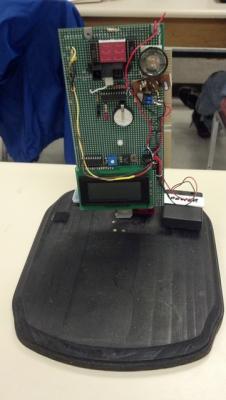Club Projects
| Betty 9 |
 |
Betty9 is an ongoing Fembot building project by Thomas Messerschmidt. This robot is a one-of-a-kind. Due to the complexities involved, you may not be able to reproduce this robot exactly, but it should give you some ideas. Contact Thomas on the link above for more information. |
| BucketBot |
 |
The BucketBot is a small PC based robot built for vision research purposes. The robot includes a CCD camera, USB Digitizer, Pentium based biscuit board CPU, and two differential motors. The BucketBot only uses its single vision sensor to sense the environment. No encoders, IR distance sensors, etc were used to test if vision can be used for multiple situations. The BucketBot has successfully accomplished various tasks such as line following and object tracking. The search is on for the originator of this project. Once a link is found, it will be updated here. |
| Cricket |
 |
Cricket is an autonomous robot that walks around by moving all six legs using three motors. He avoids objects when touched by the feelers, chirps randomly, and blinks his lights. After touching an obstacle he makes various sounds depending on which feeler sensed the object. All his functions are under control of the on board Stamp II controller. Cricket is designed to be made from readily available materials. The body is made of Lexan used in glass window replacement. The legs are made from aluminum tubing, a rubber grommet, a hinged standoff, and some plastic wire cover. Brain power comes from a Parallax Stamp II module which can be re-programmed by the user. A infrared sensor enables Cricket to respond to commands from a Sony remote control which overrides his autonomous behavior. Pushing the remote control buttons 0 - 9 causes Cricket to make various sounds and other buttons can steer his direction and actions. Power comes from nickel-cadmium batteries mounted inside his battery pack but he can also run from AA batteries. For details on building your own CRICKET, visit Henry Arnold's website. |
| E-Bot |
 |
"Ebot" is a project of the Robotics Society of Southern California. The objective is to provide a set of instructions to build a basic amateur robot. The instructions are intended to be detailed enough to allow even an inexperienced person to succeed. The goal of the project is to provide a fast route for our members to build an operating robot. The goal is to provide a discussion of the design decisions that go into designing a robot like Ebot and to provide a specific design that the members can build to; as well as enough information that the members can modify the design if they wish. For details on building your own E-BOT, visit http://abrobotics.tripod.com/Ebot/Ebottop.htm. |
| IWAH |
 |
It Worked At HomeIn February 2012, Bill presented his donation to the group of the IWAH trophy, short for "It Worked At Home," which will be awarded each month. The winner of this prestigious award will take it home and attach something to it, like a motor, sensor, electronic component, etc. Functioning components are preferred.
2012
November - No Winner
October Winner: John Honor: ?? Addition: John removed the solar panel that he had added in February, since it is almost always indoors, and reconnected the power circuits. He also added an SD card that contains documentation on the IWAH.
September - ??
August - ??
July Winner: John W Honor: Participation in the Hallway Contest Addition: Distance Sensor System (Zip of documentation)
June Winner: Jim Honor: Participation in the Hallway Contest Addition: Added the Halloween voice message to the IWAH trophy. Touching the wire at the top causes the voice to be heard. It uses the 6VDC battery pack.
May - No Winner
April - No Winner
March Winner: Thomas Honor: Addition: Flashing Red Light
February Winner: John Honor: Addition: Solar LED
|
| Leaf |
 |
Leaf is a robotics project using artificial intelligence and vision. It is a group robot development program. The objective is to develop a robot platform that supports experiments with Artificial Intelligence, vision, navigation etc. For complete information on building and programming your own LEAF robot - Visit "THE LEAF PROJECT". We meet the second Saturday of the month at CSULB (College of Engineering ECS Room 302) to discuss Leaf. This is part of the regular RSSC meetings now. |
| Plexi |
 |
Plexi is constructed using a plexiglass display dome for his top and heat bent plexiglass for the tubular body. All other parts are simple flat cut pieces. He uses a New Micros 68HC11 single board computer running BASIC11. 18 Infrared and switch bump sensors allow him to navigate around a room without bumping into things. A home brew closed loop motor control system allows accurate distance and turning motions. An RS-485 network of STAMPs and PICs provide extra functions such as LCD display, sound, and status modules. The motor gearboxes came from a child's motorized vehicle and battery power is a 12V 6ah gell cell battery. Plexi has simple maze navigation abilities and random wander routines. He also reacts to his environment using his sound and display abilities. For details on building your own PLEXI, visit Robots.net. |
| Snuffy |
 |
Alex Brown's website with details of his "Snuffy" firefighting robots, a tutorial on developing PID type control equations, various robot construction hints and more. For details on building your own "SNUFFY", visit Alex Brown's site. |

